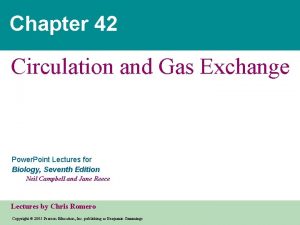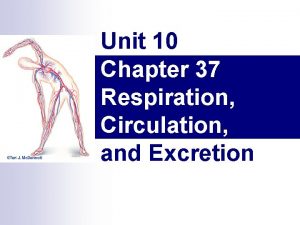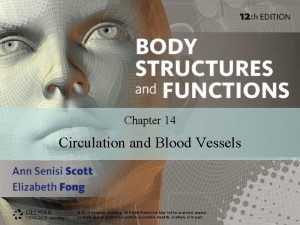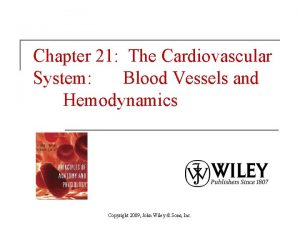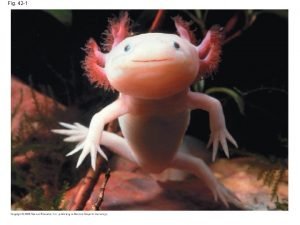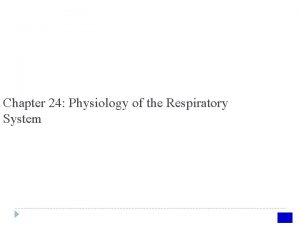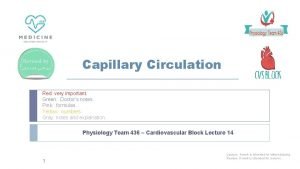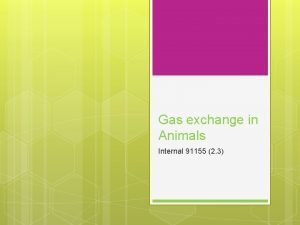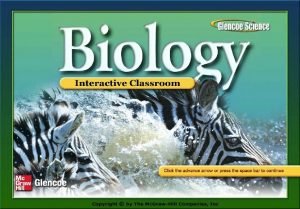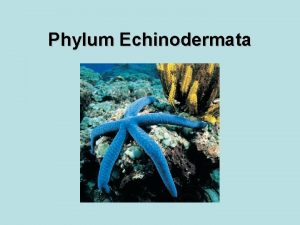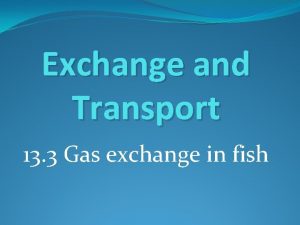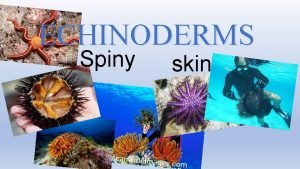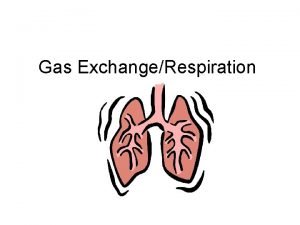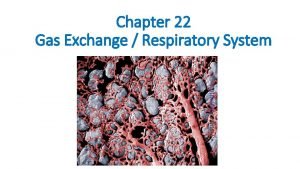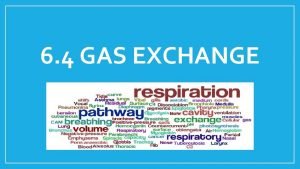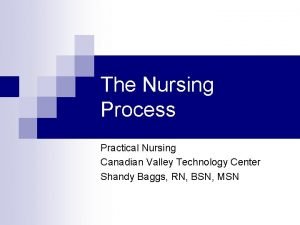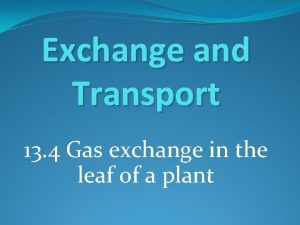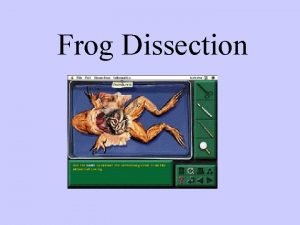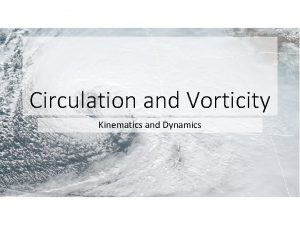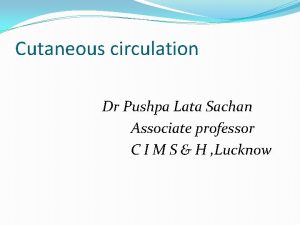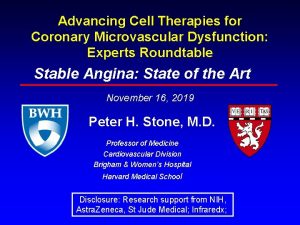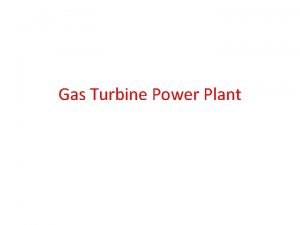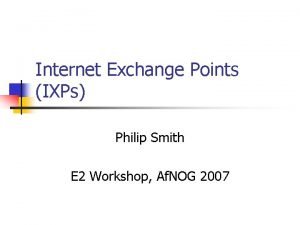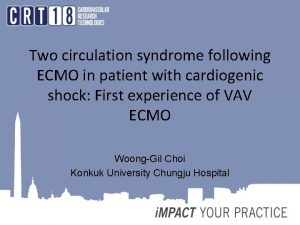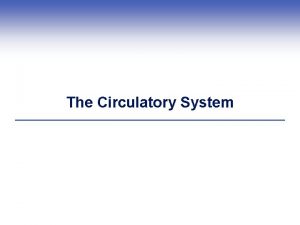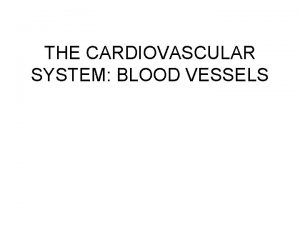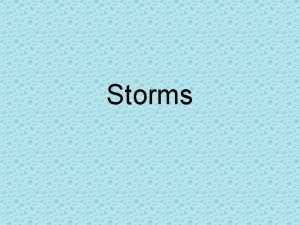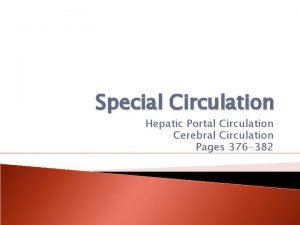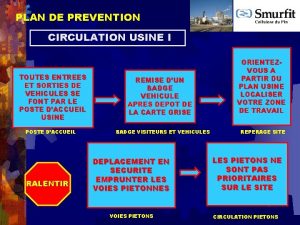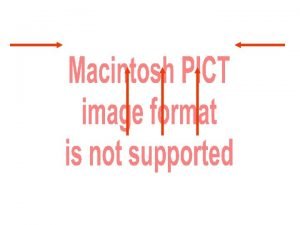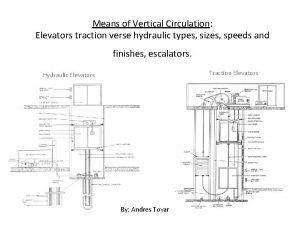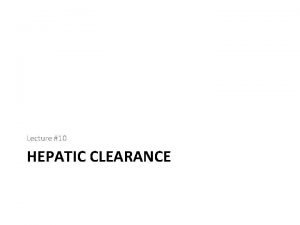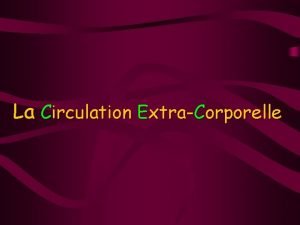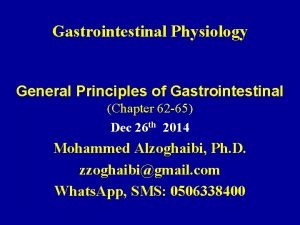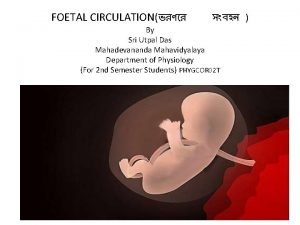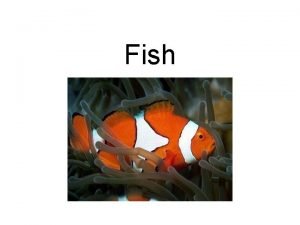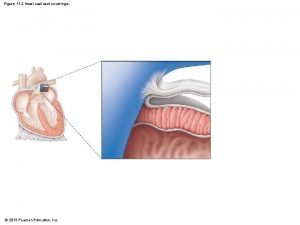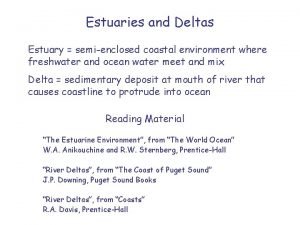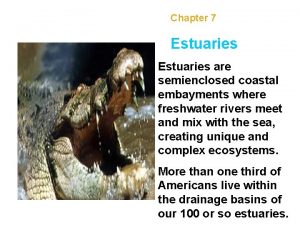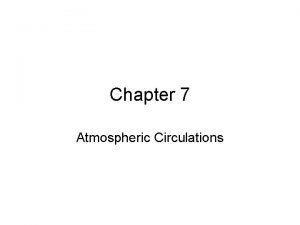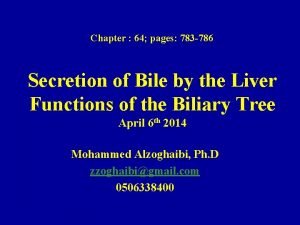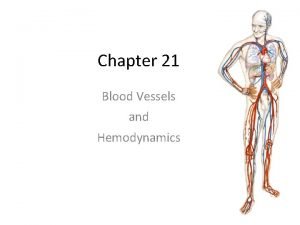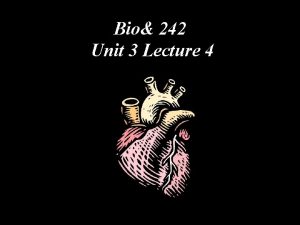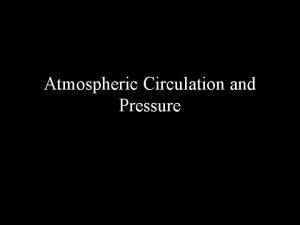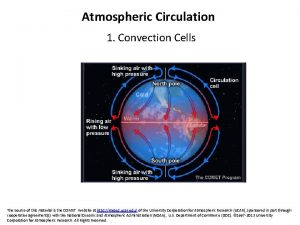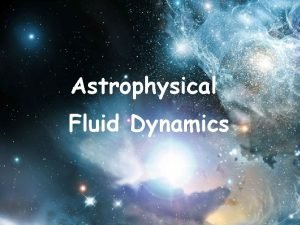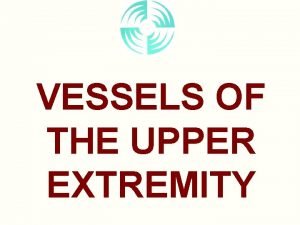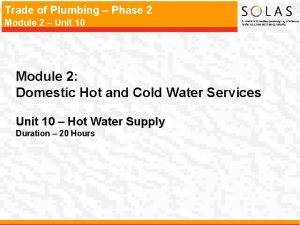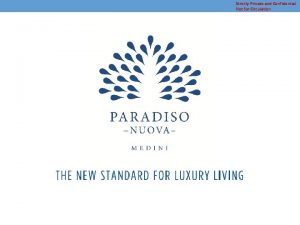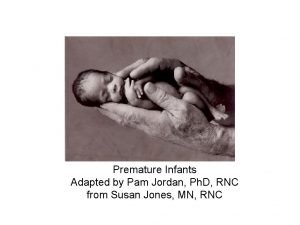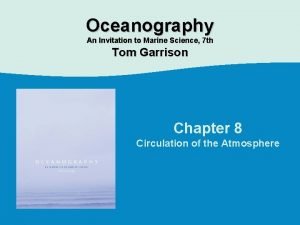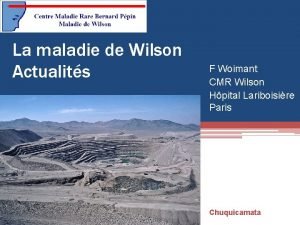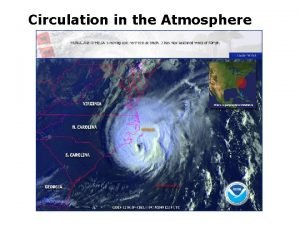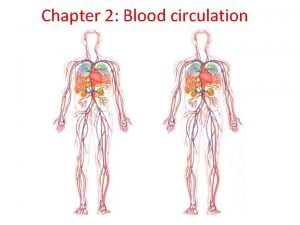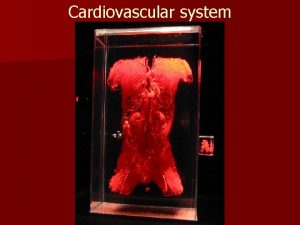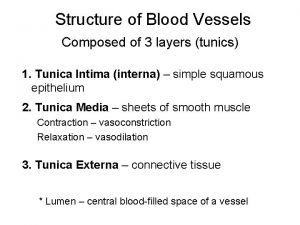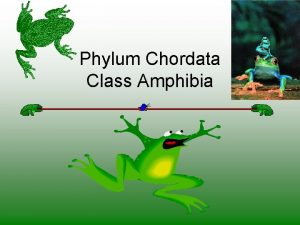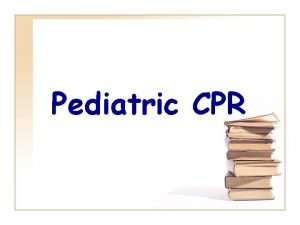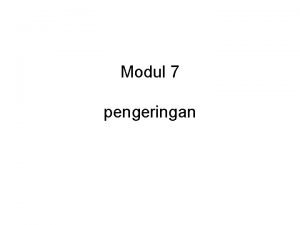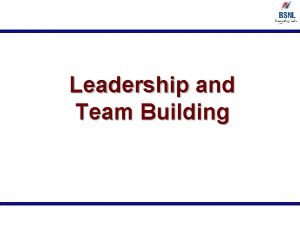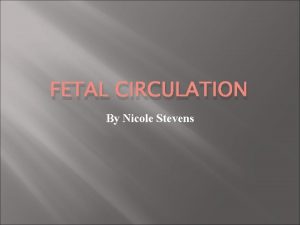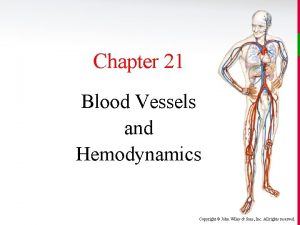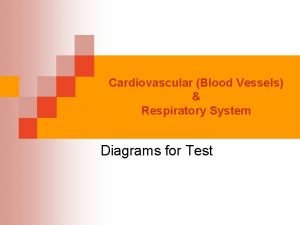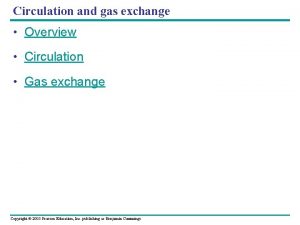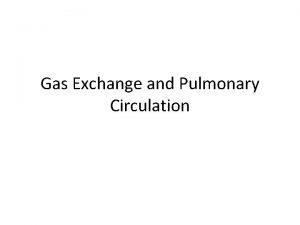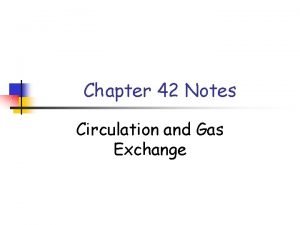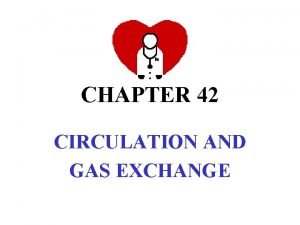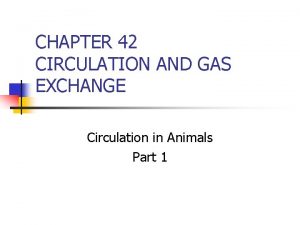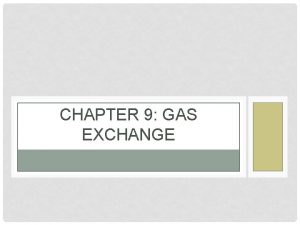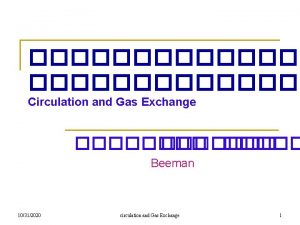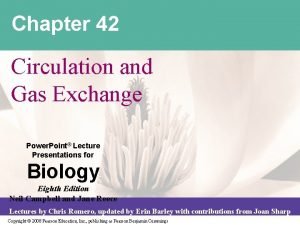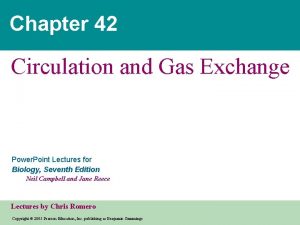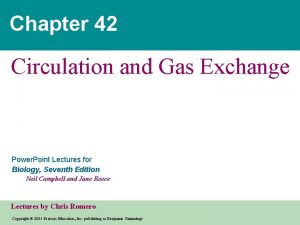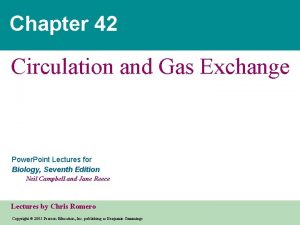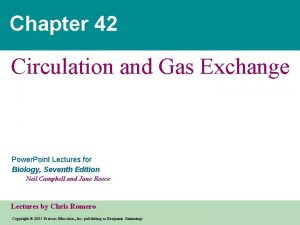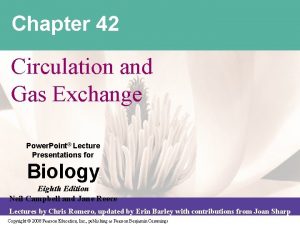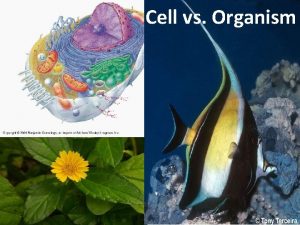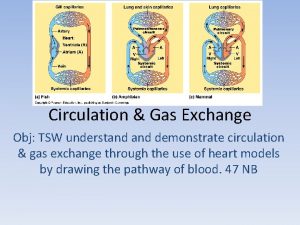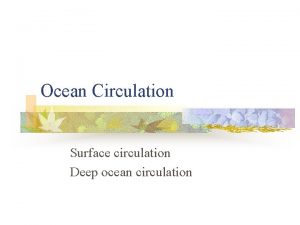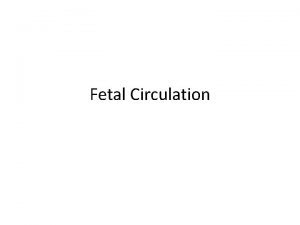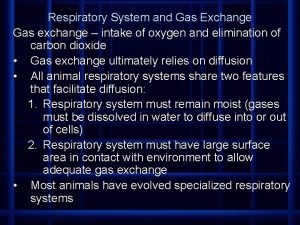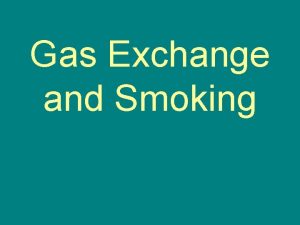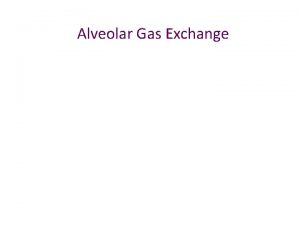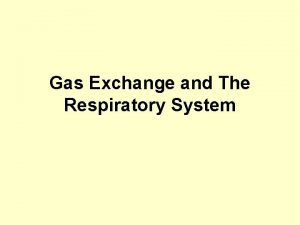Chapter 42 Circulation and Gas Exchange Power Point




































































































- Slides: 100

Chapter 42 Circulation and Gas Exchange Power. Point Lectures for Biology, Seventh Edition Neil Campbell and Jane Reece Lectures by Chris Romero Copyright © 2005 Pearson Education, Inc. publishing as Benjamin Cummings

LE 42 -2 Circular canal Mouth Radial canal 5 cm

Open and Closed Circulatory Systems • More complex animals have either open or closed circulatory systems • Both systems have three basic components: – A circulatory fluid (blood or hemolymph) – A set of tubes (blood vessels) – A muscular pump (the heart) Copyright © 2005 Pearson Education, Inc. publishing as Benjamin Cummings

• In insects, other arthropods, and most molluscs blood bathes the organs directly in an open circulatory system • There is no distinction between blood and interstitial fluid, and this general body fluid is more correctly called hemolymph Copyright © 2005 Pearson Education, Inc. publishing as Benjamin Cummings

• In a closed circulatory system, blood is confined to vessels and is distinct from the interstitial fluid • Closed systems are more efficient at transporting circulatory fluids to tissues and cells Copyright © 2005 Pearson Education, Inc. publishing as Benjamin Cummings

Survey of Vertebrate Circulation • Humans and other vertebrates have a closed circulatory system, often called the cardiovascular system • Blood flows in a closed cardiovascular system, consisting of blood vessels and a two- to fourchambered heart – Ventricles- bottom chambers in the heart that pump blood away from the heart. – Atria- top chambers in the heart that receive blood from the body Copyright © 2005 Pearson Education, Inc. publishing as Benjamin Cummings

• Arteries carry blood to capillaries, the sites of chemical exchange between the blood and interstitial fluid • Veins return blood from capillaries to the heart Copyright © 2005 Pearson Education, Inc. publishing as Benjamin Cummings

Fishes • A fish heart has two main chambers: one ventricle and one atrium • Blood pumped from the ventricle travels to the gills, where it picks up O 2 and disposes of CO 2 Copyright © 2005 Pearson Education, Inc. publishing as Benjamin Cummings

Amphibians • Frogs and other amphibians have a threechambered heart: two atria and one ventricle • The ventricle pumps blood into a forked artery that splits the ventricle’s output into the pulmocutaneous circuit and the systemic circuit Copyright © 2005 Pearson Education, Inc. publishing as Benjamin Cummings

Reptiles (Except Birds) • Reptiles have double circulation, with a pulmonary circuit (lungs) and a systemic circuit • Turtles, snakes, and lizards have a threechambered heart Copyright © 2005 Pearson Education, Inc. publishing as Benjamin Cummings

Mammals and Birds • In all mammals and birds, the ventricle is divided into separate right and left chambers • The left side of the heart pumps and receives only oxygen-rich blood, while the right side receives and pumps only oxygen-poor blood Copyright © 2005 Pearson Education, Inc. publishing as Benjamin Cummings

• A powerful four-chambered heart was an essential adaptation of the endothermic way of life characteristic of mammals and birds Copyright © 2005 Pearson Education, Inc. publishing as Benjamin Cummings

Concept 42. 2: Double circulation in mammals depends on the anatomy and pumping cycle of the heart • The human circulatory system serves as a model for exploring mammalian circulation Copyright © 2005 Pearson Education, Inc. publishing as Benjamin Cummings

Mammalian Circulation: The Pathway • Heart valves dictate a one-way flow of blood through the heart • Blood begins its flow with the right ventricle pumping blood to the lungs • In the lungs, the blood loads O 2 and unloads CO 2 • Oxygen-rich blood from the lungs enters the heart at the left atrium and is pumped to the body tissues by the left ventricle • Blood returns to the heart through the right atrium Copyright © 2005 Pearson Education, Inc. publishing as Benjamin Cummings

Animation: Path of Blood Flow in Mammals Copyright © 2005 Pearson Education, Inc. publishing as Benjamin Cummings

The Mammalian Heart: A Closer Look • A closer look at the mammalian heart provides a better understanding of double circulation – Pulmonary circuit- blood flow to the lungs and back – Systemic circulation- blood flowing around the rest of the body Copyright © 2005 Pearson Education, Inc. publishing as Benjamin Cummings

LE 42 -6 Pulmonary artery Aorta Anterior vena cava Pulmonary artery Right atrium Left atrium Pulmonary veins Semilunar valve Atrioventricular valve Posterior vena cava Right ventricle Left ventricle

• The heart contracts and relaxes in a rhythmic cycle called the cardiac cycle • The contraction, or pumping, phase is called systole • The relaxation, or filling, phase is called diastole Copyright © 2005 Pearson Education, Inc. publishing as Benjamin Cummings

• The heart rate, also called the pulse, is the number of beats per minute • The cardiac output is the volume of blood pumped into the systemic circulation per minute • AV valves- valves between the atria and ventricles – Biscuspid, tricuspid • Semilunar valves- between ventricles and body – Pulmonary semilunar, aortic semilunar Copyright © 2005 Pearson Education, Inc. publishing as Benjamin Cummings

Maintaining the Heart’s Rhythmic Beat • Some cardiac muscle cells are self-excitable, meaning they contract without any signal from the nervous system Copyright © 2005 Pearson Education, Inc. publishing as Benjamin Cummings

• The sinoatrial (SA) node, or pacemaker, sets the rate and timing at which cardiac muscle cells contract • Impulses from the SA node travel to the atrioventricular (AV) node • At the AV node, the impulses are delayed and then travel to the Purkinje fibers that make the ventricles contract Copyright © 2005 Pearson Education, Inc. publishing as Benjamin Cummings

• Impulses that travel during the cardiac cycle can be recorded as an electrocardiogram (ECG or EKG) Copyright © 2005 Pearson Education, Inc. publishing as Benjamin Cummings

• The pacemaker is influenced by nerves, hormones, body temperature, and exercise Copyright © 2005 Pearson Education, Inc. publishing as Benjamin Cummings

Concept 42. 3: Physical principles govern blood circulation • The physical principles that govern movement of water in plumbing systems also influence the functioning of animal circulatory systems Copyright © 2005 Pearson Education, Inc. publishing as Benjamin Cummings

Blood Vessel Structure and Function • The “infrastructure” of the circulatory system is its network of blood vessels • All blood vessels are built of similar tissues and have three similar layers Copyright © 2005 Pearson Education, Inc. publishing as Benjamin Cummings

• Structural differences in arteries, veins, and capillaries correlate with functions • Arteries have thicker walls that accommodate the high pressure of blood pumped from the heart Copyright © 2005 Pearson Education, Inc. publishing as Benjamin Cummings

• In the thinner-walled veins, blood flows back to the heart mainly as a result of muscle action Copyright © 2005 Pearson Education, Inc. publishing as Benjamin Cummings

LE 42 -10 Direction of blood flow in vein (toward heart) Valve (open) Skeletal muscle Valve (closed)

Blood Flow Velocity • Physical laws governing movement of fluids through pipes affect blood flow and blood pressure • Velocity of blood flow is slowest in the capillary beds, as a result of the high resistance and large total cross-sectional area Copyright © 2005 Pearson Education, Inc. publishing as Benjamin Cummings

Blood Pressure • Blood pressure is the hydrostatic pressure that blood exerts against the wall of a vessel • Systolic pressure is the pressure in the arteries during ventricular systole; it is the highest pressure in the arteries • Diastolic pressure is the pressure in the arteries during diastole; it is lower than systolic pressure • Blood pressure is determined by cardiac output and peripheral resistance due to constriction of arterioles Copyright © 2005 Pearson Education, Inc. publishing as Benjamin Cummings

LE 42 -12_4 Blood pressure reading: 120/70 Pressure in cuff above 120 Rubber cuff inflated with air Artery Pressure in cuff below 120 Pressure in cuff below 70 70 Artery closed Sounds audible in stethoscope Sounds stop

Capillary Function • Capillaries in major organs are usually filled to capacity • Blood supply varies in many other sites Copyright © 2005 Pearson Education, Inc. publishing as Benjamin Cummings

• Two mechanisms regulate distribution of blood in capillary beds: – Contraction of the smooth muscle layer in the wall of an arteriole constricts the vessel – Precapillary sphincters control flow of blood between arterioles and venules Copyright © 2005 Pearson Education, Inc. publishing as Benjamin Cummings

LE 42 -13 ab Precapillary sphincters Thoroughfare channel Arteriole Venule Capillaries Sphincters relaxed Arteriole Sphincters contracted Venule

LE 42 -13 c Capillaries and larger vessels (SEM) 20 µm

• The critical exchange of substances between the blood and interstitial fluid takes place across the thin endothelial walls of the capillaries • The difference between blood pressure and osmotic pressure drives fluids out of capillaries at the arteriole end and into capillaries at the venule end Copyright © 2005 Pearson Education, Inc. publishing as Benjamin Cummings

LE 42 -14 Tissue cell Capillary Red blood cell Net fluid movement out Net fluid movement in 15 µm Direction of blood flow Pressure Capillary INTERSTITIAL FLUID Blood pressure Osmotic pressure Inward flow Outward flow Arterial end of capillary Venous end

Fluid Return by the Lymphatic System • The lymphatic system returns fluid to the body from the capillary beds (lymph) • This system aids in body defense. Lymph nodes are the organs of the system that filter the lymph. • Fluid reenters the circulation directly at the venous end of the capillary bed and indirectly through the lymphatic system Copyright © 2005 Pearson Education, Inc. publishing as Benjamin Cummings

Concept 42. 4: Blood is a connective tissue with cells suspended in plasma • In invertebrates with open circulation, blood (hemolymph) is not different from interstitial fluid • Blood in the circulatory systems of vertebrates is a specialized connective tissue Copyright © 2005 Pearson Education, Inc. publishing as Benjamin Cummings

Blood Composition and Function • Blood consists of several kinds of cells suspended in a liquid matrix called plasma • The cellular elements occupy about 45% of the volume of blood Copyright © 2005 Pearson Education, Inc. publishing as Benjamin Cummings

Plasma • Blood plasma is about 90% water • Among its solutes are inorganic salts in the form of dissolved ions, sometimes called electrolytes • Another important class of solutes is the plasma proteins, which influence blood p. H, osmotic pressure, and viscosity • Various plasma proteins function in lipid transport, immunity, and blood clotting Copyright © 2005 Pearson Education, Inc. publishing as Benjamin Cummings

LE 42 -15 Plasma 55% Constituent Major functions Water Solvent for carrying other substances Ions (blood electrolytes) Sodium Potassium Calcium Magnesium Chloride Bicarbonate Plasma proteins Albumin Osmotic balance, p. H buffering, and regulation of membrane permeability Cellular elements 45% Cell type Number Functions per µL (mm 3) of blood Erythrocytes (red blood cells) Separated blood elements 5– 6 million Leukocytes 5, 000– 10, 000 (white blood cells) Osmotic balance, p. H buffering Fibrinogen Clotting Immunoglobulins (antibodies) Defense Substances transported by blood Nutrients (such as glucose, fatty acids, vitamins) Waste products of metabolism Respiratory gases (O 2 and CO 2) Hormones Transport oxygen and help transport carbon dioxide Defense and immunity Lymphocyte Basophil Eosinophil Neutrophil Platelets Monocyte 250, 000– 400, 000 Blood clotting

Cellular Elements • Suspended in blood plasma are two types of cells: – Red blood cells (erythrocytes) transport oxygen – White blood cells (leukocytes) function in defense • Platelets, a third cellular element, are fragments of cells that are involved in clotting Copyright © 2005 Pearson Education, Inc. publishing as Benjamin Cummings

Erythrocytes • Red blood cells, or erythrocytes, are by far the most numerous blood cells • They transport oxygen throughout the body Copyright © 2005 Pearson Education, Inc. publishing as Benjamin Cummings

Leukocytes • There are five major types of white blood cells, or leukocytes: monocytes, neutrophils, basophils, eosinophils, and lymphocytes • They function in defense by phagocytizing bacteria and debris or by producing antibodies Copyright © 2005 Pearson Education, Inc. publishing as Benjamin Cummings

Platelets • Platelets function in blood clotting Copyright © 2005 Pearson Education, Inc. publishing as Benjamin Cummings

Stem Cells and the Replacement of Cellular Elements • The cellular elements of blood wear out and are replaced constantly throughout a person’s life Copyright © 2005 Pearson Education, Inc. publishing as Benjamin Cummings

• Erythrocytes, leukocytes, and platelets all develop from a common source, pluripotent stem cells in the red marrow of bones Copyright © 2005 Pearson Education, Inc. publishing as Benjamin Cummings

LE 42 -16 Pluripotent stem cells (in bone marrow) Myeloid stem cells Lymphoid stem cells Basophils B cells T cells Lymphocytes Eosinophils Neutrophils Erythrocytes Platelets Monocytes

Blood Clotting • When the endothelium of a blood vessel is damaged, the clotting mechanism begins • A cascade of complex reactions converts fibrinogen to fibrin, forming a clot Copyright © 2005 Pearson Education, Inc. publishing as Benjamin Cummings

LE 42 -17 Endothelium of vessel is damaged, exposing connective tissue; platelets adhere Platelets form a plug Collagen fibers Platelet plug Seal is reinforced by a clot of fibrin Fibrin clot Platelet releases chemicals that make nearby platelets sticky Clotting factors from: Platelets Damaged cells Plasma (factors include calcium, vitamin K) Prothrombin Thrombin Fibrinogen Fibrin 5 µm Red blood cell

Cardiovascular Disease • Cardiovascular diseases are disorders of the heart and the blood vessels • They account for more than half the deaths in the United States Copyright © 2005 Pearson Education, Inc. publishing as Benjamin Cummings

• One type of cardiovascular disease, atherosclerosis, is caused by the buildup of cholesterol within arteries Copyright © 2005 Pearson Education, Inc. publishing as Benjamin Cummings

LE 42 -18 Connective tissue Smooth muscle Normal artery Endothelium 50 µm Plaque Partly clogged artery 250 µm

• A heart attack is the death of cardiac muscle tissue resulting from blockage of one or more coronary arteries • A stroke is the death of nervous tissue in the brain, usually resulting from rupture or blockage of arteries in the head • Hypertension, or high blood pressure, promotes atherosclerosis and increases the risk of heart attack and stroke Copyright © 2005 Pearson Education, Inc. publishing as Benjamin Cummings

Concept 42. 5: Gas exchange occurs across specialized respiratory surfaces • Gas exchange supplies oxygen for cellular respiration and disposes of carbon dioxide • Animals require large, moist respiratory surfaces for adequate diffusion of gases between their cells and the respiratory medium, either air or water Copyright © 2005 Pearson Education, Inc. publishing as Benjamin Cummings

LE 42 -19 Respiratory medium (air or water) O 2 CO 2 Respiratory surface Organismal level Circulatory system Cellular level Energy-rich fuel molecules from food Cellular respiration ATP

Gills in Aquatic Animals • Gills are outfoldings of the body surface specialized for gas exchange Copyright © 2005 Pearson Education, Inc. publishing as Benjamin Cummings

• In some invertebrates, gills have a simple shape and are distributed over much of the body Copyright © 2005 Pearson Education, Inc. publishing as Benjamin Cummings

LE 42 -20 a Gills Coelom Tube foot Sea star

• Many segmented worms have flaplike gills that extend from each segment of their body Copyright © 2005 Pearson Education, Inc. publishing as Benjamin Cummings

LE 42 -20 b Parapodia Gill Marine worm

• The gills of clams, crayfish, and many other animals are restricted to a local body region Copyright © 2005 Pearson Education, Inc. publishing as Benjamin Cummings

LE 42 -20 c Gills Scallop

LE 42 -20 d Gills Crayfish

• Effectiveness of gas exchange in some gills, including those of fishes, is increased by ventilation and the countercurrent flow of blood and water Copyright © 2005 Pearson Education, Inc. publishing as Benjamin Cummings

LE 42 -21 Oxygen-poor blood Gill arch Blood vessel 40% 70 % Gill arch 15% 30% 5% 90 % 60 % % Operculum 100 Water flow Lamella Oxygen-rich blood Gill filaments Water flow O 2 over lamellae showing % O 2 Blood flow through capillaries in lamellae showing % O 2 Countercurrent exchange

Tracheal Systems in Insects • The tracheal system of insects consists of tiny branching tubes that penetrate the body Copyright © 2005 Pearson Education, Inc. publishing as Benjamin Cummings

LE 42 -22 a Air sacs Tracheae Spiracle

LE 42 -22 b Body cell Air sac Tracheole Trachea Air Body wall Tracheoles Mitochondria Myofibrils 2. 5 µm

• The tracheal tubes supply O 2 directly to body cells Copyright © 2005 Pearson Education, Inc. publishing as Benjamin Cummings

Lungs • Spiders, land snails, and most terrestrial vertebrates have internal lungs Copyright © 2005 Pearson Education, Inc. publishing as Benjamin Cummings

Mammalian Respiratory Systems: A Closer Look • A system of branching ducts conveys air to the lungs • Air inhaled through the nostrils passes through the pharynx into the trachea, bronchioles, and dead-end alveoli, where gas exchange occurs Copyright © 2005 Pearson Education, Inc. publishing as Benjamin Cummings

LE 42 -23 Branch from pulmonary artery (oxygen-poor blood) Branch from pulmonary vein (oxygen-rich blood) Terminal bronchiole Nasal cavity Pharynx Alveoli Larynx 50 µm Right lung 50 µm Left lung Esophagus Trachea Bronchus Bronchiole Diaphragm Heart SEM Colorized SEM

Concept 42. 6: Breathing ventilates the lungs • The process that ventilates the lungs is breathing, the alternate inhalation and exhalation of air Copyright © 2005 Pearson Education, Inc. publishing as Benjamin Cummings

How an Amphibian Breathes • An amphibian such as a frog ventilates its lungs by positive pressure breathing, which forces air down the trachea Copyright © 2005 Pearson Education, Inc. publishing as Benjamin Cummings

How a Mammal Breathes • Mammals ventilate their lungs by negative pressure breathing, which pulls air into the lungs • Lung volume increases as the rib muscles and diaphragm contract Copyright © 2005 Pearson Education, Inc. publishing as Benjamin Cummings

LE 42 -24 Rib cage expands as rib muscles contract Air inhaled Rib cage gets smaller as rib muscles relax Air exhaled Lung Diaphragm INHALATION Diaphragm contracts (moves down) EXHALATION Diaphragm relaxes (moves up)

How a Bird Breathes • Birds have eight or nine air sacs that function as bellows that keep air flowing through the lungs • Air passes through the lungs in one direction only • Every exhalation completely renews the air in the lungs Copyright © 2005 Pearson Education, Inc. publishing as Benjamin Cummings

LE 42 -25 Air Anterior air sacs Air Trachea Posterior air sacs Lungs Air tubes (parabronchi) in lung INHALATION Air sacs fill EXHALATION Air sacs empty; lungs fill 1 mm

Control of Breathing in Humans • In humans, the main breathing control centers are in two regions of the brain, the medulla oblongata and the pons • The medulla regulates the rate and depth of breathing in response to p. H changes in the cerebrospinal fluid • The medulla adjusts breathing rate and depth to match metabolic demands Copyright © 2005 Pearson Education, Inc. publishing as Benjamin Cummings

• Sensors in the aorta and carotid arteries monitor O 2 and CO 2 concentrations in the blood • These sensors exert secondary control over breathing Copyright © 2005 Pearson Education, Inc. publishing as Benjamin Cummings

LE 42 -26 Cerebrospinal fluid Pons Breathing control centers Medulla oblongata Carotid arteries Aorta Diaphragm Rib muscles

Concept 42. 7: Respiratory pigments bind and transport gases • The metabolic demands of many organisms require that the blood transport large quantities of O 2 and CO 2 Copyright © 2005 Pearson Education, Inc. publishing as Benjamin Cummings

The Role of Partial Pressure Gradients • Gases diffuse down pressure gradients in the lungs and other organs • Diffusion of a gas depends on differences in a quantity called partial pressure Copyright © 2005 Pearson Education, Inc. publishing as Benjamin Cummings

• A gas diffuses from a region of higher partial pressure to a region of lower partial pressure • In the lungs and tissues, O 2 and CO 2 diffuse from where their partial pressures are higher to where they are lower Copyright © 2005 Pearson Education, Inc. publishing as Benjamin Cummings

LE 42 -27 Exhaled air Inhaled air 160 0. 2 O 2 CO 2 Alveolar epithelial cells Blood entering alveolar capillaries 40 O 2 CO 2 O 2 O C 2 Alveolar capillaries of lung O 2 CO 2 Pulmonary arteries Heart CO 104 40 O 2 CO 2 2 Systemic arteries Tissue capillaries O 2 Blood entering tissue capillaries Blood leaving tissue capillaries 45 Blood leaving alveolar capillaries Pulmonary veins Systemic veins 40 O 2 CO 2 104 40 45 O 2 CO 2 120 27 Alveolar spaces CO 2 Tissue cells < 40 > 45 O 2 CO 2 100 40 O 2 CO 2

Respiratory Pigments • Respiratory pigments, proteins that transport oxygen, greatly increase the amount of oxygen that blood can carry Copyright © 2005 Pearson Education, Inc. publishing as Benjamin Cummings

Oxygen Transport • The respiratory pigment of almost all vertebrates is the protein hemoglobin, contained in erythrocytes • Like all respiratory pigments, hemoglobin must reversibly bind O 2, loading O 2 in the lungs and unloading it in other parts of the body Copyright © 2005 Pearson Education, Inc. publishing as Benjamin Cummings

LE 42 -28 Heme group Iron atom O 2 loaded in lungs O 2 unloaded in tissues Polypeptide chain

• Loading and unloading of O 2 depend on cooperation between the subunits of the hemoglobin molecule • The binding of O 2 to one subunit induces the other subunits to bind O 2 with more affinity • Cooperative O 2 binding and release is evident in the dissociation curve for hemoglobin • A drop in p. H lowers affinity of hemoglobin for O 2 Copyright © 2005 Pearson Education, Inc. publishing as Benjamin Cummings

O 2 saturation of hemoglobin (%) LE 42 -29 a 100 O 2 unloaded from hemoglobin during normal metabolism 80 60 O 2 reserve that can be unloaded from hemoglobin to tissues with high metabolism 40 20 0 0 20 40 60 Tissues during Tissues exercise at rest PO 2 (mm Hg) 80 100 Lungs PO 2 and hemoglobin dissociation at 37°C and p. H 7. 4

O 2 saturation of hemoglobin (%) LE 42 -29 b 100 p. H 7. 4 80 Bohr shift: additional O 2 released from hemoglobin at lower p. H (higher CO 2 concentration) 60 p. H 7. 2 40 20 0 0 20 40 60 80 PO (mm Hg) 2 p. H and hemoglobin dissociation 100

Carbon Dioxide Transport • Hemoglobin also helps transport CO 2 and assists in buffering • Carbon from respiring cells diffuses into the blood plasma and then into erythrocytes and is ultimately released in the lungs Copyright © 2005 Pearson Education, Inc. publishing as Benjamin Cummings

LE 42 -30 Tissue cell CO 2 transport from tissues CO 2 produced Interstitial fluid CO 2 Blood plasma within capillary CO 2 Capillary wall CO 2 H 2 O Red H 2 CO 3 Hb blood Carbonic acid cell HCO 3– + Bicarbonate Hemoglobin picks up CO 2 and H+ H+ HCO 3– To lungs CO 2 transport to lungs HCO 3– + H 2 CO 3 H+ Hb Hemoglobin releases CO 2 and H+ H 2 O CO 2 Alveolar space in lung

Animation: O 2 From Blood to Tissues Animation: O 2 From Tissues to Blood Animation: O 2 From Blood to Lungs Animation: O 2 From Lungs to Blood Copyright © 2005 Pearson Education, Inc. publishing as Benjamin Cummings

Elite Animal Athletes • Migratory and diving mammals have evolutionary adaptations that allow them to perform extraordinary feats Copyright © 2005 Pearson Education, Inc. publishing as Benjamin Cummings

The Ultimate Endurance Runner • The extreme O 2 consumption of the antelope-like pronghorn underlies its ability to run at high speed over long distances Copyright © 2005 Pearson Education, Inc. publishing as Benjamin Cummings

Copyright © 2005 Pearson Education, Inc. publishing as Benjamin Cummings

Diving Mammals • Deep-diving air breathers stockpile O 2 and deplete it slowly Copyright © 2005 Pearson Education, Inc. publishing as Benjamin Cummings
 Chapter 42 circulation and gas exchange
Chapter 42 circulation and gas exchange Gas exchange key events in gas exchange
Gas exchange key events in gas exchange Single circulation and double circulation
Single circulation and double circulation Single circulation and double circulation
Single circulation and double circulation Pulmonary arterioles
Pulmonary arterioles Chapter 37 respiration circulation and excretion
Chapter 37 respiration circulation and excretion Chapter 14 circulation and blood vessels
Chapter 14 circulation and blood vessels Chapter 21 hemodynamics
Chapter 21 hemodynamics Real power and reactive power
Real power and reactive power Powerbi in powerpoint
Powerbi in powerpoint Point point power
Point point power Bioflix activity: gas exchange -- inhaling and exhaling
Bioflix activity: gas exchange -- inhaling and exhaling Pulmonary gas exchange and transport diagram
Pulmonary gas exchange and transport diagram Capillary tissue fluid exchange diagram
Capillary tissue fluid exchange diagram Gas exchange in plants and animals venn diagram
Gas exchange in plants and animals venn diagram Chapter 34 circulation in humans concept mapping answer key
Chapter 34 circulation in humans concept mapping answer key Chapter 34 circulation in humans concept mapping answer key
Chapter 34 circulation in humans concept mapping answer key Determination of exchange rate
Determination of exchange rate Pearl exchange activity
Pearl exchange activity Differences between ideal gas and real gas
Differences between ideal gas and real gas Difference between ideal gas and real gas
Difference between ideal gas and real gas Gas exchange lungs
Gas exchange lungs Crinoidea
Crinoidea Gas exchange in fish a level biology aqa
Gas exchange in fish a level biology aqa A(n) _____ has an endoskeleton and usually a spiny skin.
A(n) _____ has an endoskeleton and usually a spiny skin. Grasshopper respiratory system
Grasshopper respiratory system Xerophytic adaptations
Xerophytic adaptations Egrette chapter 22
Egrette chapter 22 Gallant
Gallant Gas exchange
Gas exchange Impaired gas exchange subjective data
Impaired gas exchange subjective data Examples of sponges invertebrates
Examples of sponges invertebrates Gas exchange
Gas exchange External respiration
External respiration Frog dissection
Frog dissection Vorticity and circulation
Vorticity and circulation Triple response and cutaneous circulation
Triple response and cutaneous circulation Micro and macro circulation
Micro and macro circulation Bat characteristics
Bat characteristics Advantages and disadvantages of gas turbine power plant
Advantages and disadvantages of gas turbine power plant Pseudo reduced specific volume
Pseudo reduced specific volume Imaginary gas
Imaginary gas Ideal gas vs perfect gas
Ideal gas vs perfect gas Reason for bhopal gas tragedy
Reason for bhopal gas tragedy Gas leaked in bhopal gas tragedy
Gas leaked in bhopal gas tragedy Gas reale e gas ideale
Gas reale e gas ideale Flue gas desulfurisation gas filter
Flue gas desulfurisation gas filter Poisonous gas leaked in bhopal gas tragedy
Poisonous gas leaked in bhopal gas tragedy Kinetika kimia
Kinetika kimia Hub and spoke airport
Hub and spoke airport Ppp exchange rate
Ppp exchange rate Example of internet exchange point
Example of internet exchange point Two circulation syndrome
Two circulation syndrome Single loop blood circulation
Single loop blood circulation Pulmonary circulation pathway
Pulmonary circulation pathway Circulation of air masses
Circulation of air masses Hepatic portal vein.
Hepatic portal vein. Exemple plan de circulation usine
Exemple plan de circulation usine Teeth of herbivorous animals
Teeth of herbivorous animals Net migration definition ap human geography
Net migration definition ap human geography Types of vertical circulation
Types of vertical circulation Liver circulation
Liver circulation Circulation extracorporelle
Circulation extracorporelle Secretion of bicarbonate ions
Secretion of bicarbonate ions Fetal circulation flow chart
Fetal circulation flow chart Fish phylum
Fish phylum Intrinsic conduction system of the heart
Intrinsic conduction system of the heart Estuary circulation
Estuary circulation Estuary circulation
Estuary circulation Single cell model of atmospheric circulation
Single cell model of atmospheric circulation Bile components
Bile components Vessel
Vessel Chapter 11 the cardiovascular system figure 11-3
Chapter 11 the cardiovascular system figure 11-3 Chapter 11 the cardiovascular system figure 11-3
Chapter 11 the cardiovascular system figure 11-3 Fetal circulation flow chart
Fetal circulation flow chart Single cell model of atmospheric circulation
Single cell model of atmospheric circulation Convection circulation
Convection circulation Internal energy formula
Internal energy formula Collateral circulation definition
Collateral circulation definition One pipe circulation
One pipe circulation Confidential not for circulation
Confidential not for circulation 3 shunts of fetal circulation
3 shunts of fetal circulation Circulation cells
Circulation cells Circulation sanguine
Circulation sanguine Guest circulation pattern
Guest circulation pattern Atmospheric circulation
Atmospheric circulation Circulation
Circulation Figure 11-9 is a diagram of the hepatic portal circulation
Figure 11-9 is a diagram of the hepatic portal circulation Mojo magazine target audience
Mojo magazine target audience Vacate hyperemia
Vacate hyperemia Capillary bed labeled
Capillary bed labeled Frog heart
Frog heart Airway breathing c
Airway breathing c Cross circulation drying
Cross circulation drying For internal circulation only
For internal circulation only Poiseuille's law in blood flow
Poiseuille's law in blood flow Fetal circulation definition
Fetal circulation definition Arteries of the systemic circulation
Arteries of the systemic circulation Umbilical arteries
Umbilical arteries Respiratory system nasal cavity
Respiratory system nasal cavity Human blood circulation
Human blood circulation
